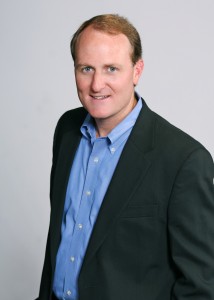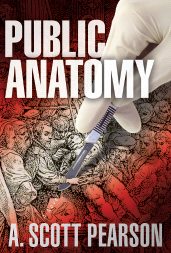Public Anatomy by A. Scott Pearson
A. Scott Pearson’s novel Public Anatomy, a Publishers Weekly Editor’s Pick, is due out in hardcover March 7 in parallel with the paperback release of Pearson’s first medical thriller Rupture.
Here’s the jacket copy:
While recovering from a career-threatening injury, surgeon Eli Branch is pulled into the turbulent world of Dr. Liza French, a colleague he hasn’t seen in ten years. Liza uses their past to lure Eli into a highly-publicized debacle in a Memphis hospital that has put her own career in jeopardy. But when the murder of medical personnel at Gates Memorial appears related to Liza’s surgical complication, Eli finds that more lives are at imminent risk.
Eli discovers clues from the victims that match anatomical art found at the crime scenes, a connection that leads him to the manuscript of a sixteenth century anatomist whose methods of dissection are over four centuries old-but are being re-enacted in the present. Aided by the expertise of forensic pathologist, Dr. Meg Daily, Eli uncovers a pattern to the escalating deaths and the search begins for a killer the media and the city come to know as The Organist.
New York Times bestselling author Steve Berry calls Public Anatomy, “A TANTALIZING PREMISE COMBINED WITH TIGHT SUSPENSE MAKES THIS ONE DELICIOUS TALE.”
International bestselling author Kathryn Fox says, “PUBLIC ANATOMY IS COMPELLING—FIRST CLASS MEDICAL DETAIL, PACE AND SUSPENSE. A CHILLING READ!”
Dissection, ancient manuscripts and modern science, I’m intrigued. Luckily, A. Scott Pearson has graciously agreed to an interview in advance of his multi-city book tour.
Hello, Scott, and thank you for joining me.
 Your protagonist, Eli Branch, is a surgeon like yourself. What makes him tick?
Your protagonist, Eli Branch, is a surgeon like yourself. What makes him tick?
He’s young, just finished surgical training, and is eager to start his career as an academic surgeon. Unfortunately for him, he falls toward the dark side of medicine and his career derails in spectacular fashion.
Meg Daily, a forensic pathologist, became Eli Branch’s partner in Rupture, and we see more of her in Public Anatomy. Is there a romantic side to their relationship?
The tension is there but not fully realized, yet. And Meg has got some competition this time in the shapely figure of Dr. Liza Branch.
Can you tell us a little more about the genesis of Public Anatomy? Where did you get the idea from?
I began to write as a way to confront the challenges of today’s medicine. It was not so much a conscious effort to write a novel. But then the character Eli Branch came along and I could give these problems to him. And my first novel, Rupture, took off. One theme in Public Anatomy stems from my concern that today’s medicine is becoming hands—off and impersonal. I still believe that patients want and need the touch of another human being.
Is Public Anatomy a standalone novel or should readers read Rupture first?
Public Anatomy is the next book, after Rupture, in this series of medical suspense. So the story line and characters continue – but one doesn’t have to have read Rupture to enjoy the ride of Public Anatomy.
Public Anatomy opens with a surgeon conducting a remote procedure – how do you see new technology improving things? What are the risks to removing the human element? Is there an advantage to getting your hands dirty and having your finger on the pulse of things so to speak?
I think that the technology available to patients today is amazing. But we as physicians have to know when to contain it. If you take your car in for repairs, that’s exactly what you get. The medical profession can always intervene with tests and fancy procedures. Sometimes, however, that intervention is worse than the disease. But it’s against our culture to acknowledge that. Some aspects of today’s medicine scare me. The technology is so powerful. Sometimes that power doesn’t fit with the complexity of the human body. It’s my experience that the medical profession still finds a way to avoid full disclosure to patients and society. That creates an infraction that drives my writing.
In your thriller, SurgCast, a surgery documentarian that broadcasts surgeries online shows another side of making anatomy public. Are we really so interested in surgery to want to watch others undergo procedures online? Is this voyeurism, sadism, exposure therapy, what?
This is the ultimate reality show, I guess. Advertising and marketing drive it forward. What was once held sacred – the human body undergoing deeply invasive procedures – is now for public viewing. There certainly can be an educational component and that’s good – but I hope that we as a society don’t lose the awe-inspiring view of the human body, a view that should remain inherent in all of us.
Rupture took on the biopharmaceutical industry and Public Anatomy appears to take aim at remote technologies, but this isn’t the only antagonist in this novel, can you tell me about The Organist, the serial killer who is carving people up in Memphis?
The Organist, as he comes to be called by the media, is driven by the failures of his past. So while he is evil, one can identify with this human aspect, while not condoning his actions.
The Organist is using a 16th century manuscript by Andreas Vesalius, De Humani Corporis Fabrica as the basis for his crimes. What’s he doing and can you tell us more about the manuscript, its author, and how you came to discover it?
Andreas Vesalius was a renegade anatomist in the 16th century who is considered the father of human anatomy. His manuscript, the Fabrica, ushered in the age of modern medicine. The research on Vesalius and his work was fascinating.
Your bio says you teach about the importance of the ‘patient’s narrative’ at Vanderbilt University. What’s a patient narrative and why is it important?
Patient narratives are simply their stories, or what’s important to them in the context of their illness. As physicians, we sometimes forget the rich life experience that individuals have before entering the illness experience. If we practice narrative medicine, we strive to understand the patient’s story, so that we might optimize care.
What’s next for Eli Branch? Can we expect to hear from him again?
I’m always working on the next Eli Branch novel—so stay tuned.
You must be excited, Scott, I hope you can keep your hands from shaking the next time you go into the OR! Thanks for taking the time out of your schedule to answer my questions.
A. Scott Pearson is a surgeon in Nashville, Tennessee. For the past decade, he has been a member of the surgical faculty at Vanderbilt University, where he combines research with the clinical practice of surgery and teaches on the importance of the patient’s narrative in medicine. PUBLIC ANATOMY is his second novel. To learn more about A. Scott Pearson, visit his website www.ascottpearson.com.
- The Bourne Retribution by Eric Van Lustbader - November 30, 2013
- Nightlife by Matthew Quinn Martin - October 31, 2013
- Bones of the Lost by Kathy Reichs - August 31, 2013

